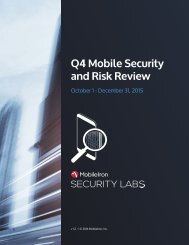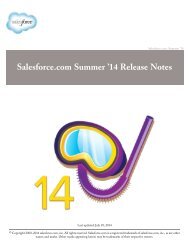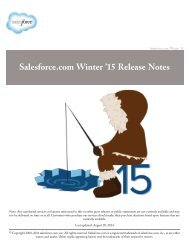salesforce_security_impl_guide
salesforce_security_impl_guide
salesforce_security_impl_guide
You also want an ePaper? Increase the reach of your titles
YUMPU automatically turns print PDFs into web optimized ePapers that Google loves.
Enabling Single Sign-On<br />
• Increased Security: Any password policies that you have established for your corporate network will also be in effect for Salesforce.<br />
In addition, sending an authentication credential that is only valid for a single use can increase <strong>security</strong> for users who have access<br />
to sensitive data.<br />
Delegated Authentication Best Practices<br />
Consider the following best practices when <strong>impl</strong>ementing delegated authentication single sign-on for your organization.<br />
• Your organization’s <strong>impl</strong>ementation of the Web service must be accessible by <strong>salesforce</strong>.com servers. This means you must deploy<br />
the Web service on a server in your DMZ. Remember to use your server’s external DNS name when entering the Delegated<br />
Gateway URL in the Delegated authentication section in Salesforce (from Setup, click Security Controls > Single Sign-On<br />
Settings).<br />
• If <strong>salesforce</strong>.com and your system cannot connect, or the request takes longer than 10 seconds to process, the login attempt fails.<br />
An error is reported to the user indicating that his or her corporate authentication service is down.<br />
• Namespaces, element names, and capitalization must be exact in SOAP requests. Wherever possible, generate your server stub from<br />
the WSDL to ensure accuracy.<br />
• For <strong>security</strong> reasons, you should make your Web service available by SSL only. You must use an SSL certificate from a trusted provider,<br />
such as Verisign or Thawte. For a full list of trusted providers, contact <strong>salesforce</strong>.com.<br />
• The IP address that originated the login request is sourceIp . Use this information to restrict access based on the user’s location.<br />
Note that the Salesforce feature that validates login IP ranges continues to be in effect for single sign-on users. For more information,<br />
see Setting Login Restrictions on page 40.<br />
• You may need to map your organization’s internal usernames and Salesforce usernames. If your organization does not follow a<br />
standard mapping, you may be able to extend your user database schema (for example, Active Directory) to include the Salesforce<br />
username as an attribute of a user account. Your authentication service can then use this attribute to map back to a user account.<br />
• We recommend that you do not enable single sign-on for system administrators. If your system administrators are single sign-on<br />
users and your single sign-on server has an outage, they have no way to log in to Salesforce. System administrators should always<br />
be able to log in to Salesforce so they can disable single sign-on in the event of a problem.<br />
• We recommend that you use a Developer Edition account or a sandbox when developing a single sign-on solution before<br />
<strong>impl</strong>ementing it in your organization. To sign up for a free Developer Edition account, go to developer.<strong>salesforce</strong>.com.<br />
• Make sure to test your <strong>impl</strong>ementation with Salesforce.com clients such as Salesforce for Outlook, Connect for Office, and Connect<br />
Offline. For more information, see Single Sign-On for Salesforce clients.<br />
Federated Authentication using SAML Best Practices<br />
Consider the following best practices when <strong>impl</strong>ementing federated single sign-on with SAML for your organization.<br />
• Obtain the Salesforce Login URL value from the Single Sign On Settings configuration page and put it in the corresponding<br />
configuration parameter of your Identity Provider (sometimes called the “Recipient URL”).<br />
• Salesforce allows a maximum of three minutes for clock skew with your IDP server; make sure your server’s clock is up-to-date.<br />
• If you are unable to log in with SAML assertion, always check the login history and note the error message. Use the SAML Assertion<br />
Validator on the Single Sign On Settings configuration page to troubleshoot.<br />
• You need to map your organization’s internal usernames and Salesforce usernames. You have two choices to do this: add a unique<br />
identifier to the FederationIdentifier field of each Salesforce user, or extend your user database schema (for example,<br />
Active Directory) to include the Salesforce username as an attribute of a user account. Choose the corresponding option for the<br />
SAML User ID Type field and configure your authentication service to send the identifier in SAML assertions.<br />
90






